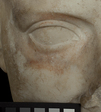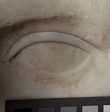Portrait head of Tiberius
Summary
This report presents the work on a Roman marble portrait of the emperor Tiberius dated to the 1st century CE. Red is predominant the polychromy of the portrait and is visible to the naked eye on the hair and in areas around the eyebrows, left eye, lips and especially below the right eye where extensive remains of red appears. The red pigment is analysed with XRF in situ and shows a content of iron (Fe) which represent the used of iron oxides. It seems like the pigment has been applied directly onto the marble surface
Description of object
The portrait has a wide smooth forehead and short hair which is combed forward. The hair at the back of the head is long. The eyes are large and rounded. The mouth has thin lips with the upper lip protruding conspicuously. Two furrows radiate from the top root of the nose and there is a prominent chin. The hair over the forehead is parted close to the middle of the forehead, just above the inner corner of the left eye. The portrait is in an overall good condition. Tip of the nose and the left earlobe have broken off. Most of the neck has broken off and is missing. Superficial scratches are evenly coving the surface. Incrusation is particular seen on the right side of the face and the back of the head while traces due to biological growth are seen on the left side of the portrait. Traces of gypsum are observed in the hair and behind the right ear.
Choice of methods
Visual examination
- Macroscopic
- Microscopic in situ
Technical imaging
- UV
- VIL
Sampling
- XRF
Visual examination
Red is predominant the polychromy of the portrait and is visible to the naked eye on the hair and in areas around the eyebrows, left eye, lips and especially below the right eye where extensive remains of red appears. It seems like the pigment has been applied directly onto the marble surface. Microscope in situ investigation also shows few remains of red in the iris of the right eye, on the chin, on both ears and on the right side of the jaw line.
Technical imaging
UV-FL: The original marble surface appears in general light brown. A smaller area in the forehead and next to the right eye shows a discreet greenish fluorescence. The small particles which have a strong blue fluorescence are properly dust. Areas with red paint absorb the UV-FL light and appears dark red.
VIL: The portrait was examined by means of VIL imaging without any indication of the use of Egyptian blue
Other types of investigation
XRF: XRF examination in situ of remains of red under the left eye exhibited a high content of iron (Fe) which, additionally testifies to the presence of a Fe-oxide based pigment such as red ochre
Bibliography
F. Johansen 1994, Catalogue. Roman Portraits I. Ny Carlsberg Glyptotek, Copenhagen, cat. No. 47.
F. Poulsen 1951, Catalogue of Ancient Sculpture in the Ny Carlsberg Glyptotek, Copenhagen, cat. No. 624.
M.L. Sargent & R.H. Therkildsen 2010, The Technical Investigation of Sculptural Polychromy at the Ny Carlsberg Glyptotek 2009-2010 – An Outline. Tracking colour. The polychromy of Greek and Roman sculpture in the Ny Carlsberg Glyptotek. Preliminary Report 2, 27-49. Download.
- IN 1750
- Portrait
- Original: 10-20 C.E. Copy: 14-37 C.E
- Roman Imperial
- White marble
- Bought in 1900 in Rome.
- H. 36.5 cm.; W. 26 cm.; D. 26 cm.








